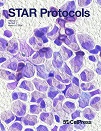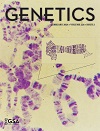Latest Publications
Detection of membrane fission in single Bacillus subtilis cells during endospore formation with high temporal resolution
 Ane Landajuela, Martha Braun, Christopher D.A. Rodrigues, Erdem Karatekin
Ane Landajuela, Martha Braun, Christopher D.A. Rodrigues, Erdem Karatekin
Membrane fission is an essential process in all domains of life. The underlying mechanisms remain poorly understood in bacteria, partly because suitable assays are lacking. Here, we describe an assay to detect membrane fission during endospore formation in single Bacillus subtilis cells with a temporal resolution of ∼1 min. Other cellular processes can be quantified and temporally aligned to the membrane fission event in individual cells, revealing correlations and causal relationships.
Peptidoglycan synthesis drives a single population of septal cell wall synthases during division in Bacillus subtilis
 Kevin D. Whitley, James Grimshaw, David M. Roberts, Eleni Karinou, Phillip J. Stansfeld & Seamus Holden
Kevin D. Whitley, James Grimshaw, David M. Roberts, Eleni Karinou, Phillip J. Stansfeld & Seamus Holden
Bacterial cell division requires septal peptidoglycan (sPG) synthesis by the divisome complex. Treadmilling of the essential tubulin homologue FtsZ has been implicated in septal constriction, though its precise role remains unclear. Here we used live-cell single-molecule imaging of the divisome transpeptidase PBP2B to investigate sPG synthesis dynamics in Bacillus subtilis. In contrast to previous models, we observed a single population of processively moving PBP2B molecules whose motion is driven by peptidoglycan synthesis and is not associated with FtsZ treadmilling. However, despite the asynchronous motions of PBP2B and FtsZ, a partial dependence of PBP2B processivity on FtsZ treadmilling was observed. Additionally, through single-molecule counting experiments we provide evidence that the divisome synthesis complex is multimeric. Our results support a model for B. subtilis division where a multimeric synthesis complex follows a single track dependent on sPG synthesis whose activity and dynamics are asynchronous with FtsZ treadmilling.
The contribution of an X chromosome QTL to non-Mendelian inheritance and unequal chromosomal segregation in A. freiburgense
 Talal Al-Yazeedi, Sally Adams, Sophie Tandonnet, Anisa Turner, Jun Kim, Junho Lee, Andre Pires-daSilva
Talal Al-Yazeedi, Sally Adams, Sophie Tandonnet, Anisa Turner, Jun Kim, Junho Lee, Andre Pires-daSilva
Auanema freiburgense is a nematode with males, females, and selfing hermaphrodites. When XO males mate with XX females, they typically produce a low proportion of XO offspring because they eliminate nullo-X spermatids. This occurs because of an unequal distribution of essential cellular organelles during sperm formation. Intriguingly, the interbreeding of two A. freiburgense strains results in hybrid males capable of producing viable nullo-X sperm. Consequently, when these hybrid males mate with females, they yield a high percentage of male offspring. To uncover the genetic basis of nullo-spermatid elimination and X- chromosome drive, we generated a genome assembly for A. freiburgense, and genotyped the intercrossed lines. This analysis identified a Quantitative Trait Locus spanning several X chromosome genes linked to the non-Mendelian inheritance patterns observed in A. freiburgense. This finding provides valuable clues to the underlying factors involved in asymmetric organelle partitioning during male meiotic division and thus non-Mendelian transmission of the X chromosome and sex ratios.
Liver sinusoidal cells eliminate blood-borne phage K1F
 Javier Sánchez Romano, Jaione Simón-Santamaria, Peter McCourt, Bård Smedsrød, Kim Erlend Mortensen, Antonia P. Sagona, Karen Kristine Sørensen, Anett Kristin Larsen
Javier Sánchez Romano, Jaione Simón-Santamaria, Peter McCourt, Bård Smedsrød, Kim Erlend Mortensen, Antonia P. Sagona, Karen Kristine Sørensen, Anett Kristin Larsen
Blood-borne phages are believed to be captured by macrophages in the liver and spleen. Since liver sinusoids also consist of specialized scavenger liver sinusoidal endothelial cells (LSECs) and Kupffer cells (KCs), this study investigated the contribution of both cell types in the elimination of Escherichia coli phage K1Fg10b::gfp (K1Fgfp) in mice. The results presented herein contribute to increased knowledge about the pharmacokinetics of the T7-like phage K1F in the mammalian system. The cell types of the liver that are responsible for rapid phage blood clearance are identified. Our results highlight the need for more research about appropriate dose regimens when phage therapy is delivered intravenously and advise essential knowledge about cell systems that should be investigated further for detailed phage pharmacodynamics.
NCAM mimetic peptide P2 synergizes with bone marrow mesenchymal stem cells in promoting functional recovery after stroke
 Lan X.Y., Liang X.S., Cao M.X., Qin H.M., Chu C.Y., Boltze J., Li S.
Lan X.Y., Liang X.S., Cao M.X., Qin H.M., Chu C.Y., Boltze J., Li S.
The neural cell adhesion molecule (NCAM) promotes neural development and regeneration. Whether NCAM mimetic peptides could synergize with bone marrow mesenchymal stem cells (BMSCs) in stroke treatment deserves investigation. We found that the NCAM mimetic peptide P2 promoted BMSC proliferation, migration, and neurotrophic factor expression, protected neurons from oxygen-glucose deprivation through ERK and PI3K/AKT activation and anti-apoptotic mechanisms in vitro. Following middle cerebral artery occlusion (MCAO) in rats, P2 alone or in combination with BMSCs inhibited neuronal apoptosis and induced the phosphorylation of ERK and AKT. P2 combined with BMSCs enhanced neurotrophic factor expression and BMSC proliferation in the ischemic boundary zone. Moreover, combined P2 and BMSC therapy induced translocation of nuclear factor erythroid 2-related factor, upregulated heme oxygenase-1 expression, reduced infarct volume, and increased functional recovery as compared to monotreatments. Treatment with LY294002 (PI3K inhibitor) and PD98059 (ERK inhibitor) decreased the neuroprotective effects of combined P2 and BMSC therapy in MCAO rats. Collectively, P2 is neuroprotective while P2 and BMSCs work synergistically to improve functional outcomes after ischemic stroke, which may be attributed to mechanisms involving enhanced BMSC proliferation and neurotrophic factor release, anti-apoptosis, and PI3K/AKT and ERK pathways activation.
Journal of Cerebral Blood Flow & Metabolism. January 2024
Screening of Hydrophilic Polymers Reveals Broad Activity in 2 Protecting Phages during Cryopreservation
 Huba L Marton, Apoorva Bhatt, Antonia P Sagona, Peter Kilbride, Matthew I Gibson
Huba L Marton, Apoorva Bhatt, Antonia P Sagona, Peter Kilbride, Matthew I Gibson
Bacteriophages have many biotechnological and therapeutic applications, but as with other biologics, cryopreservation is essential for storage and distribution. Macromolecular cryoprotectants are emerging for a range of biologics, but the chemical space for polymer-mediated phage cryopreservation has not been explored. Here we screen the cryoprotective effect of a panel of polymers against five distinct phages, showing that nearly all the tested polymers provide a benefit. This work shows that phages are amenable to protection with hydrophilic polymers and opens up new opportunities for advanced formulations for future phage therapies and to take advantage of the additional functionality brought by the polymers.
